Phase 2
I’ve observed before that we’ve seen
price strength and constructive pattern formation in the defense and aerospace
arena. We’re seeing more of the same in these groups.
Newport News Shipbuilding
(
NNS |
Quote |
Chart |
News |
PowerRating)
and Northrop Grumman
(
NOC |
Quote |
Chart |
News |
PowerRating), featured in my Feb.
21 commentary, have moved further ahead.

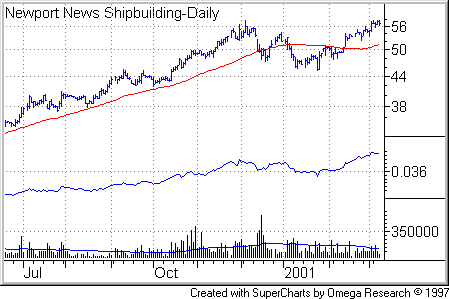
Other base builders shaping up with
strong relative
strength lines include Boeing
(
BA |
Quote |
Chart |
News |
PowerRating) and General Dynamics
(
GD |
Quote |
Chart |
News |
PowerRating).
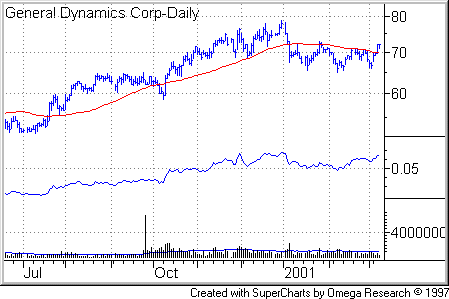
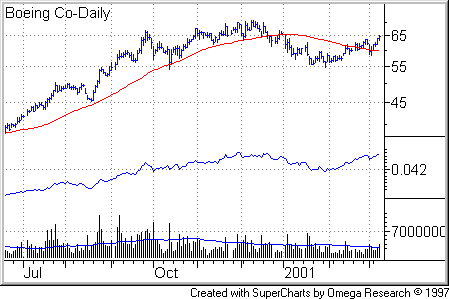
Is there are bigger cyclical picture
shaping up? My friend Dave Steckler,
an intermediate-term player and institutional equity advisor with LPL Financial
Services, pointed out that the group action is consistent a Phase 2 cyclical
rally. Phase 2 stocks are in the basic materials and tech groups. Basic
materials include aluminum (check out Alcoa Aluminum
(
AA |
Quote |
Chart |
News |
PowerRating)), chemicals, forest
products and paper products (e.g., International Paper
(
IP |
Quote |
Chart |
News |
PowerRating)), mining,
precious metals and steel. Tech sectors include aerospace and defense,
communications, computers, diversified technology, industrial technology,
medical, biotech, office equipment, semis and Software.
Now don’t expect all of these groups
to shape up into tradable bases with relative strength support in unison. But
these are good areas for you to search for limited-exposure trading while we
wait — maybe for quite a while! — for the high earnings growth stocks to shape
up. I also recommend you not commit a large part of your account in this area.
You can play patterns and relative strength in these areas, but our
intermediate-term momentum style works optimally with growth stocks.
For further Phase 2 evidence, Dave
pointed out today’s cup-with-handle breakout by Minnesota Mining &
Manufacturing
(
MMM |
Quote |
Chart |
News |
PowerRating). The stock has not yet moved into new high ground, so it
could consolidate here and set up again.Â
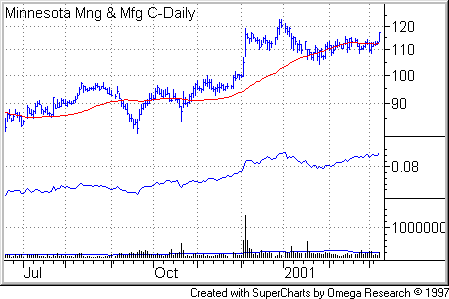
I also would point to the strength shown by the Dow Jones Basic Materials iShares
(
IYM |
Quote |
Chart |
News |
PowerRating), which added 1.9% Thursday. The tradable fund, which is listed on the
Amex, includes such stocks as DuPont
(
DD |
Quote |
Chart |
News |
PowerRating), Alcoa
(
AA |
Quote |
Chart |
News |
PowerRating), Weyerhaeuser
(
WY |
Quote |
Chart |
News |
PowerRating)
and Union Carbide
(
UK |
Quote |
Chart |
News |
PowerRating).
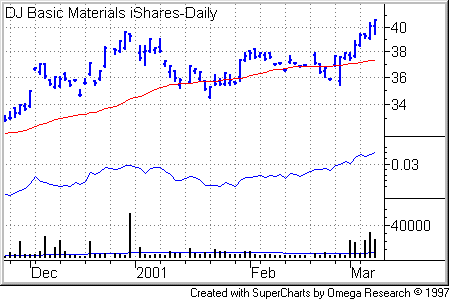
Remember my guidelines not to buy
stocks until they have retraced at least half of the loss of their corrections.
Buy earlier, and you run the risk of seeing your stock’s share price fall as
overhead supply comes to market. Overhead supply represents shares in
the hands of shareholders who bought at higher prices. These share
holders — so-called weak holders — tend to sell into rallies to end their
unhappy experience in the stock. For that reason, I generally insist that my
watch list stocks are trading above their mid levels for looking for entries. To find a stock’s mid level,
sum the pre-correction high and the post-correction low, then divide the
result by 2.
The top field of all charts in this
commentary uses a logarithmic price scale and displays a 50-day price average in
red. In the second field, a
blue relative strength line represents the displayed security’s price
performance relative to the S&P 500. The third field displays vertical daily
volume bars in black with a 50-day moving average in blue for volume.
All stocks, of course, are risky. On
any new trade, be sure to limit your position size and set a protective price
stop where you will sell your buy or cover your short to protect yourself
against severe losses. For an introduction to combining price stops with
position sizing, see my lesson,
Risky Business.
